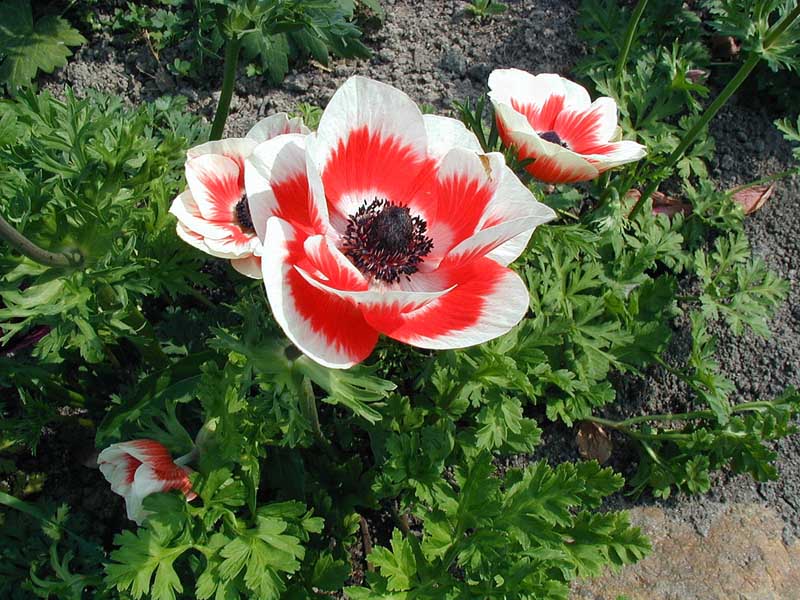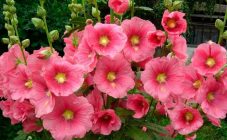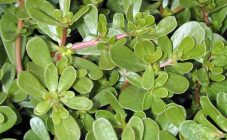Content:
The genus of perennial herbaceous flowers, called anemone (anemone), is very diverse, because it includes about 170 species of all shades of the rainbow. In the garden culture, such varieties as Japanese, crown, tender, forest have taken root. All types of anemones can be divided into 2 categories: tuberous and rhizome. If we talk about rhizomes, then they mainly include all wild-growing species (forest), but tuberous flowers are most often found in gardens and in stores.
Lush greenery, flowers impressive in brightness and size are the hallmarks of anemones. Petals of large flowers (up to 10 cm in diameter) flutter in the wind with such sensitivity that they seem to be able to catch even the smallest movement of air. Outwardly, anemone resembles a little poppies, but more have nothing to do with them.
Anemones: how to plant in open ground
For anemones, planting and caring in the open field is not particularly difficult. This happens in the spring. If the flower reproduces by rhizomes, then they are divided before active sap flow begins. First, they note when the buds of the new season hatch on the flower bed, then they begin to divide the rhizomes. When deciding when to plant anemones - in the fall or spring, it is worth considering that if you perform the same operation in the fall (in September), then the number of seedlings that have taken root in a new place will be much lower than with a spring transplant. Therefore, this type of breeding is not popular.
You can buy tubers at the store. Every year, more and more interesting shades appear on sale that can become a true decoration of any flower bed. When choosing planting material, you need to pay attention to the size of the tubers. The bigger the better. If the nodule is too small, it means that it did not have enough nutrition in the previous year. Such a plant is unlikely to be able to bloom in the first year, and even if this happens, the flower will be small.
The optimal planting time for tuberous anemone is early April. If the spring is late in the region, then they are first planted in pots, and after distilling the shoots on the flower bed, the flower is transplanted, after the threat of frost return has passed by 100% (in May).
Preparing the soil and planting material for planting
Cultivated varieties of anemones (except for forest) are very demanding on the looseness and fertility of soils. Only the forest anemone blooms beautifully and reproduces on rather poor and sandy soils, but such Spartan conditions are not suitable for the rest. Garden flowers are preferred to grow in light soils rich in nutrients.
As for the acid-base indicator, then:
- Apennine, crown and Caucasian anemone prefer pH <5;
- pH = 5-8 is suitable for all other varieties.
The Canadian and forked anemones, which need peaty or sandy soils that freely pass water through themselves without stagnation, are distinguished by their exactingness to the structure of soils. If the soil on the site is too heavy, then when digging, peat, sand, vermiculite are added to it.
Tuberous rhizomes need to provide liming of the soil, achieving an increase in soil acidity to a pH of 7-8.A large amount of wood ash is introduced into the ground before planting, which continues to be added a little during the year.
If the planting material belongs to hybrid varieties, then all of them are very demanding on the amount of organic fertilizers applied to the soil. The pH is not so important for them, as the amount of humus or rotted manure introduced into the ground since autumn.
When preparing for planting work, it is important to remember that all varieties of anemone without exception have an extremely negative attitude towards transplanting. The sensitive root system after digging up the plant is very difficult to take root in a new place.
There are also ephemeroids that appear only in the spring. They quickly wake up, drive out their flower stalks, delight with beautiful flowers, and by June they completely wither and disappear. These flowers are transplanted in summer. It should be noted the place where this anemone grew, and when its ground part completely withers, dig up a piece of rhizome with a bud and transplant it to another flower bed. Moreover, it is not necessary to bury it deeply, only 2-5 cm is enough.
All varieties of anemones, except for hybrids, are easily propagated by seeds. The flowers are bisexual, and after wilting they form a box with seeds, which can be sown next year on seedlings or directly into the ground. Moreover, stratification increases the chances of friendly shoots several times. The term of their appearance is 2-3 weeks.
If the planting material is tubers, then they are soaked for a day before planting, but not in a container with water. You will need a damp cloth and a container with a lid. Nodules are wrapped in a damp cloth, and after a day they can be planted in a flower bed.
Anemone: planting and care
The recommended planting and growing scheme for most varieties of anemone is 15x15 cm. This is quite enough so that the plants do not drown out each other. At the same time, after 2-3 years, quite enough planting material is formed around the mother bushes so that you can dig out rhizomes or young nodules and plant them in your garden plot.
When planting, it should be borne in mind that in a place of constant growth, anemone needs access to water. If there is too little natural rainfall in summer and spring, then regular watering will be required. Moreover, it is highly undesirable to use tap water for these purposes. It is best to keep a barrel nearby, in which water will collect naturally, and also settle after filling from the mains. You will have to water the bushes until they completely wither.
Top dressing is applied for the first time after the first green leaves appear. Nitrogen-containing preparations are optimal. If there is no desire or opportunity to use chemical fertilizers, then it is quite possible to get by with a quail mullein, which is mixed with ash and poured under the bushes several times per season.
When forming buds, it is recommended to apply a complex mineral fertilizer. This allows you to increase the number of flowers and the duration of flowering. In the fall, if you do not plan to dig up the roots or tubers, then any fertilizer without nitrogen is applied, for example, potassium monophosphate.
Caring for anemones after flowering
If the growing region is warm enough, then after the disappearance of the terrestrial part of the anemone, they do not need any additional care. But mulching will solve several issues at once:
- Get rid of weeds that find it difficult to overcome such an obstacle.
- Avoid drying out the soil too quickly in hot climates.
- Introduce additional nutrients into the ground that are easily assimilated by all types of plants.
- Prevent freezing of the root part in the winter season.
Do I need to dig up anemones for the winter or not
Varieties of anemone, which completely stop growing in the summer, need to provide a rest regime. To do this, they are dug up in July-August and stored in a dry, ventilated room at a temperature of about 20 ° C. The planting material should dry well. Already in the fall, it is sprinkled with wet sand and stored in the basement, where the temperature is maintained at about 4 ° C.
Digging up anemones for the winter or not depends on how frosty the winter is in the region. With good shelter with spruce branches or mulch, plants will not die even in a 20-degree frost, but they may not survive a tougher winter. When digging, the planting material should be sorted out immediately. All spoiled and damaged parts are removed. To avoid the spread of mold or fungi, rhizomes and tubers are recommended to be washed in a weak solution of manganese or fungicide. After that, they are laid out in the shade to dry.
Planting and caring for anemones in the open field in the Moscow region, Siberia, in the Urals
Where the summer is short and the winters "delight" with frosts stronger than 30 ° C, all varieties of anemones need to be dug out for the winter. Rhizomes and tubers are stored in basements with a constant temperature of about 4 ° C in boxes with sand. It is enough to visit them once a month to slightly moisten the sand.
Landing is carried out when warm weather is established without the risk of frost return. After the ground part of the plant has completely wilted, its root part is dug out to preserve it in winter. Or you can collect seeds and sow seedlings in the spring. The digging method is preferable, since the seedlings do not always please with flowering in the first year.
If in the south anemone is planted, choosing a place for them in partial shade, then in the northern regions, on the contrary, it is worth choosing a sunny flower bed, where there will be enough light for the formation of buds and abundant flowering.
Among the much more capricious spring flowers, anemones are favorably distinguished by the fact that they do not need any special care. Periodic feeding and watering - that's all. From time to time (every 2-3 years), it will be necessary to plant young growth, that is, investments in the purchase of new varieties pay off quickly enough.

















